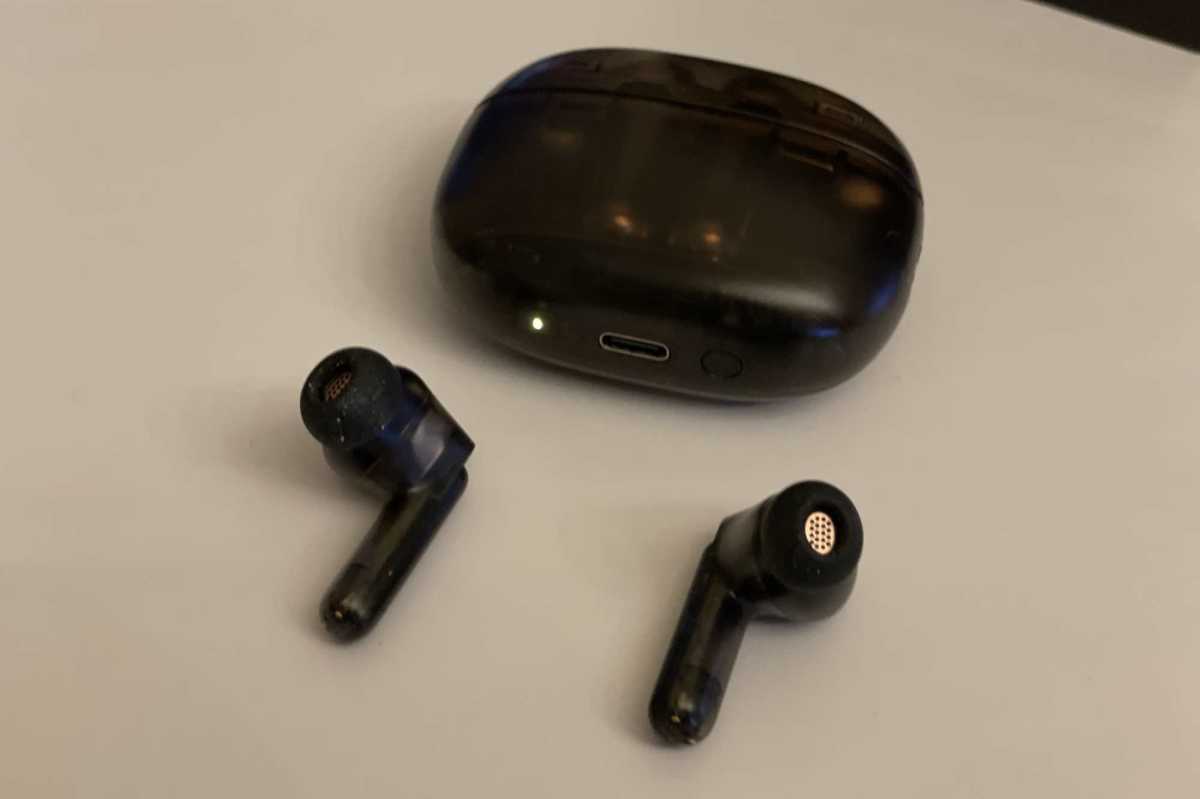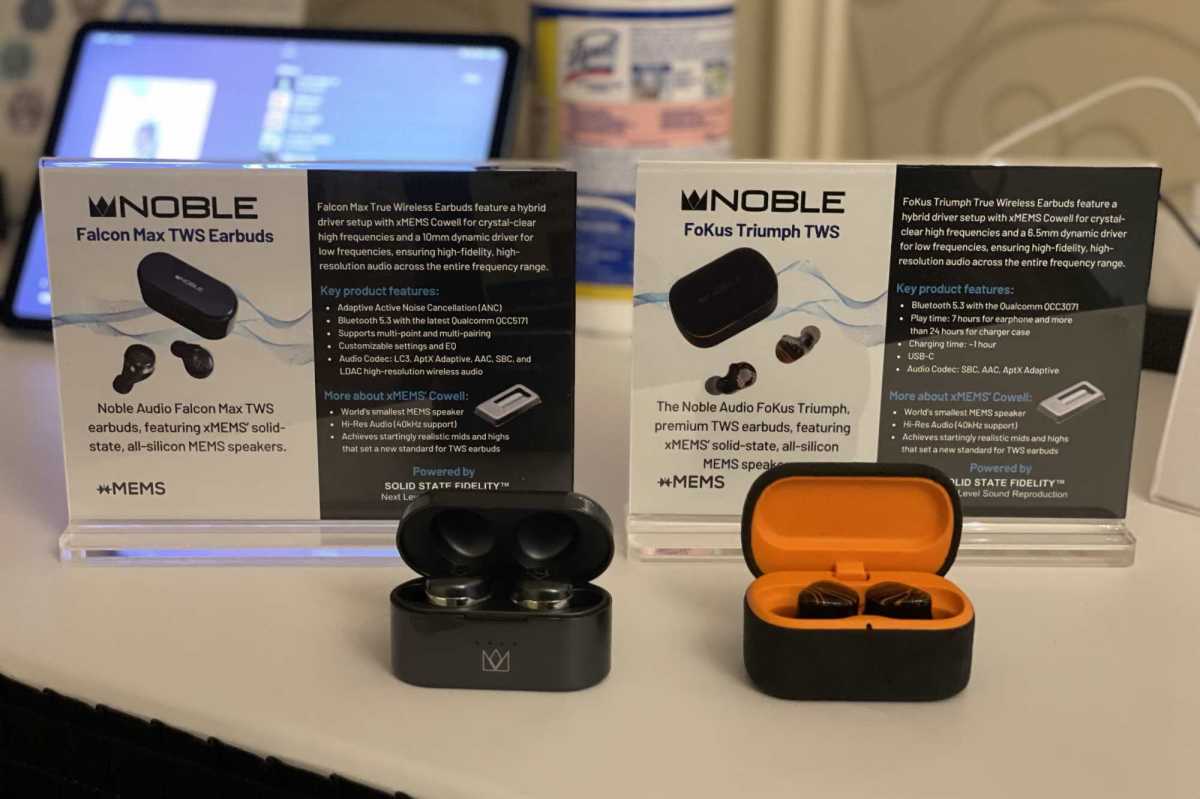At this year’s CES, Santa Clara-based xMEMS Labs has been showing off newly released, first-generation earbuds from Creative Labs and Noble Audio utilizing the developer’s breakthrough MEMS micro-speakers.
What is MEMS (short for “micro electrical mechanical systems”) technology all about? We’re talking about “microscopic moving structures inside a silicon chip,” detailed Mike Housholder, the company’s marketing and business development VP. “They actuate to move air, creating pressure which generates sound. There are some actual moving parts in these microchips, but their flexing is so minute it can’t be seen by the naked eye.”
Those all-silicon solid-state components deliver better reliability, part-to-part consistency, and equal-to-better (eventually) pricing, Housholder argues. “And for the consumer, we think [the MEMS speaker] has the most accurate reproduction you’re going to get.” (We covered xMEMS’ MEMS micro-speakers in detail earlier this year.)
“Almost every component in electronic devices has moved to solid state, with the exception of the ‘coil and magnet’ driven dynamic speaker,” Housholder noted. But with its MEMS technology, xMEMS aims to put the kibosh on that last holdout.
The best of the new MEMS-fitted earbuds I tried in the developer’s CES suite were the Aurvana Ace 2 ($149) and–almost as good–the $129 Aurvana Ace, both from Creative Labs, which demonstrated a well-balanced, natural, and effortlessly detailed performance on a wide variety of music, from pop (Olivia Rodrigo) to cool jazz (Miles Davis) and even bombastic classical (Carl Orff’s Carmina Burana.)

Creative Labs Aurvana Ace earbuds are first to exploit MEMS solid-state micro-speakers
Jonathan Takiff/Foundry
But had I looked under the hood, I would have seen that the buds’ two-way coaxial design was actually a bit of new-tech-meets-old-tech. That’s because buds are utilizing xMEMS’ Cowell-model MEMS chip to produce the scintillating high frequencies, while conventional dynamic drivers tackle the bass and mid-range duties.
That will change next year, when the chip designer introduces yet another and equally staggering breakthrough in its Cypress-series MEMS: an ultrasonic signal coding and decoding process that could boost the micro-speaker’s bass response by a factor of 40, meaning it wouldn’t need help from a friend.
Improved low-frequency sound pressure levels would allow the Cypress chip to support active noise cancellation, which requires 140 decibels of signal-cancelling muscle power to do its job. The Cypress series also makes the micro-speaker technology ripe for high resolution and spatial audio, says the developer.
Audio delivery schemes riding on ultrasound waves have been a research topic since the 1960s, and until now, they’ve never achieved a performance level good enough for broad audience appeal. But a prototype Cypress micro-speaker I got to hear kicked plenty of butt.

Noble Audio’s MEMS-equipped Falcon Max are exclusive to the Japanese market, whle their FoKus Triumph will be available worldwide.
Jonathan Takiff/Foundry
“Cypress uses a modulator to generate an amplitude modulated ultrasonic wave carrier that faithfully follows the amplitude of the intended audio signal,” Housholder explained, “and a demodulator to synchronously demodulate the ultrasonic wave, transferring the acoustic energy down to the baseband, which is the audio signal. So we’re now using ultrasound as the pressure generator instead of just pushing air, which is the conventional mechanism for generating sound.”
xMEMS also demonstrated the effective capabilities of its technology with its prototype over-the-ear “Presidio” headphone, which is likely to show up next year under a different brand name. This design deploys the solid-state Cowell micro-speaker in a two-way architecture.
“The Cowell is mounted in this little compression horn, functioning as the tweeter, with a dynamic driver in the back,” Housholder explained. “This takes a lot of weight out. It simplifies the design. A lot of effort goes into tuning the back volume of the headphone to get the mids and the highs sounding right. The MEMS drivers don’t care about back volumes. So you can make this back shell thin, [and] save a lot of design time and complexity.”
As if that wasn’t enough, xMEMS Labs is also hoping to make a dent in the sleep-buds category with a yet-to-be-named headset that integrates a unique “dynamic vent” in addition to one of its specialty chips. This user-controlled mechanical vent can be left open when your environment is quiet, or cued to close if your bedmate is snoring the night away.
I was told the vent closure will cut outside sounds by 30 decibels, but with the less-than-perfectly fitted prototype I tried on, the dampening was only promising at best.


